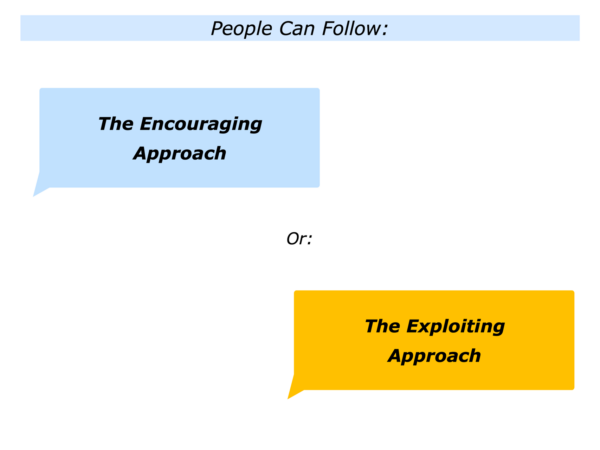
This is an approach followed by people who aim to do superb work in their area of expertise. They aim to develop rather than be distracted by outside noise.
Different people follow this approach in different ways. Let’s look at some examples.
The Writer’s Approach
During my twenties I met a famous woman novelist who described how she focused on her work. The author of several best-selling books, she described her working day in the following way.
“My day starts by feeding the family and taking the kids to school. Driving back home, I plan what I am going to write that day. Moving to my desk, I then have five hours where I can concentrate fully on my work.
“Sometimes there are emergencies, such as a call from school if one of the children has got ill. But for the most part I am able to become totally absorbed in the work.”
This is a pattern I saw repeated by other writers. During the early 1970s a group of us travelled from London to Cornwall to meet another famous author.
We arrived at around 11.00, but the writer continued to follow his daily creative ritual until 13.00. Only then did he emerge to spend two hours answering our questions. He believed in doing the work by cutting out any other distractions.
Creative workers follow certain rituals to focus on pursuing their craft or area of expertise. They pursue these habits without thinking. They reserve their thinking power for cutting out distractions and developing the art or knowledge.
Mason Currey described how such people apply elements of this approach in his books Daily Rituals: How Artists Work and Daily Rituals: Women At Work. Here is an excerpt from what Mason says about Maya Angelou. This is followed by other examples from the books.
For many years, Angelou worked in hotel or motel rooms, the more anonymous the better. In 1983 she told an interviewer:
“I keep a hotel room in which I do my work – a tiny, mean room with just a bed, and sometimes, if I can find it, a face basin. I keep a dictionary, a bible, a deck of cards and a bottle of sherry in the room.
“I try to get there around 7, and I work until 2 in the afternoon. If the work is going badly, I stay until 12.30. If it’s going well, I’ll stay as long as it is going well. It’s lonely, and it’s marvellous.”
Descartes liked to linger in bed, his mind wandering in sleep through woods, gardens, and enchanted palaces where he experienced ‘every pleasure imaginable’.
George Gershwin worked for twelve hours a day from late morning to midnight, composing at the piano in pyjamas, bathrobe and slippers. Igor Stravinsky was never able to compose unless he was sure no one could hear him and, when blocked, stood on his head to clear the brain.
Barbara Hepworth sculpted outdoors, Janet Frame wore earmuffs as she worked to block out noise. Kate Chopin wrote with her six children ‘swarming around her’ whereas the artist Rosa Bonheur filled her bedroom with the sixty birds that inspired her work.
Louisa May Alcott wrote so vigorously – skipping sleep and meals – that she had to learn to write with her left hand to give her cramped right hand a break.
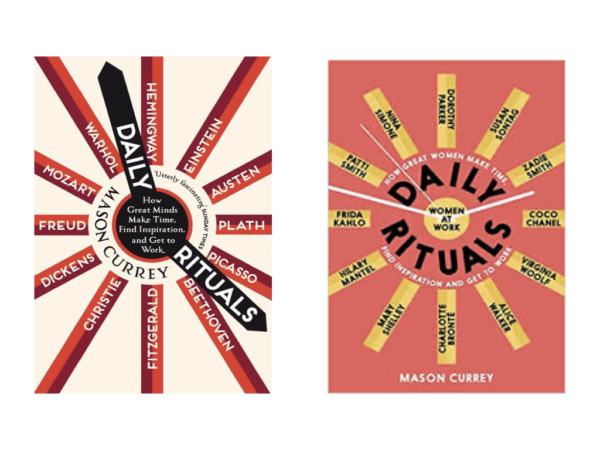
Let’s explore another way that some people aim to focus on their chosen work, be innovative or develop knowledge.
The Innovation Takes Place Away
From The Institution Approach
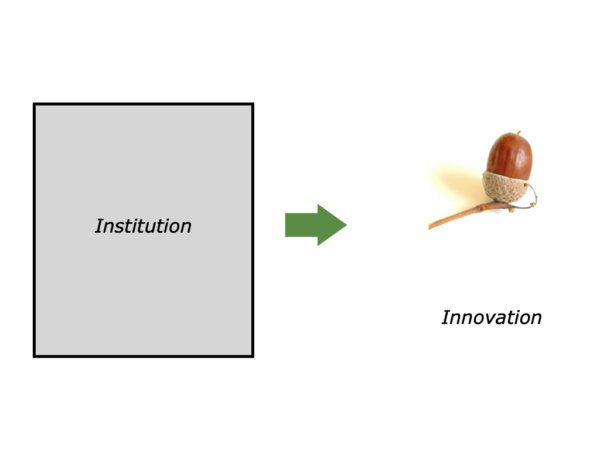
Many innovators try to spend time away from institutions in order to develop new ideas. The institution may be a building, organisation or another body that has an ambivalent attitude towards creative thinking.
Some innovators may still belong to an organisation but they create some kind of distance. This may be a physical distance, such as working at home or in their own laboratory. Or it may be a psychological distance, such as doing things differently.
Several years ago I worked with a pioneering film maker who was invited to lead a traditional organisation. His brief was to shift the culture and make it fit for purpose.
The Board asked him to take over because he was known for delivering success. They expressed this in the following way.
“We love your energy and innovative approach. We must embrace those qualities to survive in the modern world.”
Arriving on the first day, he was given a tour of the building. He was then told about the schedule that had been arranged.
“We have put together a plan for your first two months. Here is a schedule of all the committees you need to attend.
“The diary looks full but it is important that you meet these people and attend these functions. We are sure that you can use your personality to win over even the toughest doubters.”
The person attended some functions but then created a different schedule. Within six months he had delivered a superb campaign that won national recognition for the organisation.
The success was not appreciated, however, because he had failed to use the organisation’s traditional channels. He left to do imaginative work that has been lauded across the world.
Being innovative often calls for people having the freedom to think rather than deal with the internal noise created by institutions. People need to spend time focusing on creative solutions rather than trying to persuade committees.
Buckminster Fuller expressed this in the following way.
“You never change things by fighting the existing reality. To change something, build a new model that makes the existing model obsolete.”
Sometimes it is easier to make this happen when breathing the fresh air. One person expressed this in the following way.
“I spent years working inside organisations trying to persuade people to change. But I was battling against the nature of systems theory.
“Systems move towards homeostasis – the drive to return to their present state. Sometimes this can be good because it can create stability. But sometimes it can be dangerous because it can prevent development.
“Systems sometimes drive out the creativity they need to survive. So I have found other ways to develop new ideas.”
The Maintaining Your Sanity
During Insane Times Approach
Many people who do superb work face a challenge. They want: a) to focus on their work: b) to know what is happening in the world; c) to also manage their emotions about the crazy things that are happening.
How to take these steps? Some individuals concentrate on the following themes to maintain their sanity during challenging times.
Control – They start by focusing on what they can control in the specific situation.
Cocooning – They create a safe and stimulating place where they can protect themselves from distracting influences.
Creative Work – They aim to build on their strengths and do creative work.
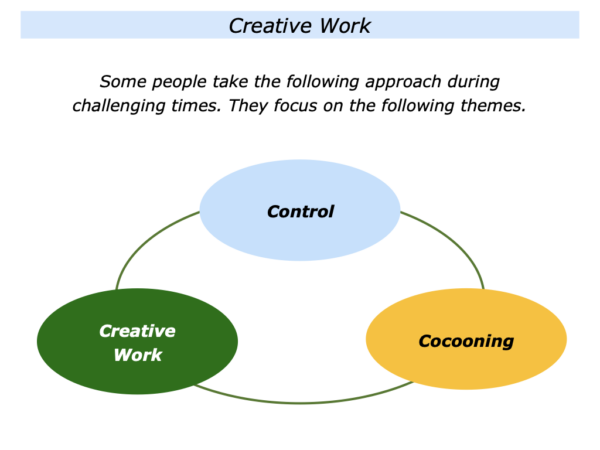
Control
They start by focusing on what they can control in a potentially challenging situation. A person who wants to encourage other people, for example, may take this approach when feeling overwhelmed by events happening around the world.
One person took this approach after feeling depressed about the votes for Brexit and the 2016 US Presidential Election. They described what they did in the following way.
“I tried to be encouraging and kind in my daily life and work. The aim was to care for other people and the planet rather than to give in to cruelty.”
Cocooning
There are many forms of cocooning. Whilst Faith Popcorn popularised the term in the 1980s, it is an approach that has been followed by many people throughout history. Different people do cocooning in different ways.
Some do it by going into a sanctuary to gain comfort. Some do it by creating a safe place that is also stimulating. Some aim to do creative work by cutting off outside noise. Let’s explore these themes.
Cocooning For Comfort
Some individuals follow the cocooning approach to find comfort. They may rest, sleep or spend time in their chosen sanctuary. They may stay at home or do other things that bring solace to their soul.
Many people take this step to recentre. They may do it for hours, days or even years. Spending time in the cocoon can help them to refresh themselves. There may come a time, however, when they want to emerge.
Such individuals may then go out into the world to learn, do a stimulating project or aim to achieve a specific goal. They may go through the process of absorption, adventure and achievement.
They may sometimes return to their sanctuaries to make sense of what is happening and regain their strength. They may then alternate between spending time in their cocoon and being creative in the world.
Cocooning For Creating
Some people follow the cocooning approach when doing creative work. Many writers, painters, sculptors, designers, thinkers and others have taken this route throughout history.
Such individuals aim to create a safe place that can also be stimulating They aim to focus fully when pursuing their work. They therefore protect themselves from various influences that may be distracting.
Cocooning For Tackling Challenges
Some individuals follow the cocooning approach when tackling challenges. They often start by gathering lots of information before settling on their strategy. They then focus fully on following their chosen process for working to achieve their goal.
Many athletes, golfers and other sports people describe how they follow this approach. They talk about being in their bubble but also being present in the moment.
They may have a positive mantra they say to themselves to keep focusing on the task in hand. They stay in the present rather than get ahead of themselves. Such individuals then do their best to achieve their picture of success.
Creative Work
Some people may follow a daily rhythm for doing creative work. They may pursue a craft, write a book, make music, develop software, provide virtual mentoring, run a business from home or do another activity.
Some may focus on following the principles of stability, stimulation and success. They gain stability by being in their safe place but they also aim to get stimulation.
Some individuals get inspiration from books, music, art, exercise or other activities. Some get it from occasionally going out into the world to find solutions to challenges or help people. They may then do creative work and aim to achieve their picture of success.
Let’s return to the theme of developing rather than being distracted by noise. Can you think of a situation where you may want to follow this approach in your own way?
How can you stay focused on doing your chosen work? How can you maybe cocoon yourself and cut out any interference? How can you encourage yourself and do your best to achieve your picture of success?
If you wish, try tackling the exercise on this theme. This invites you to complete the following sentences.
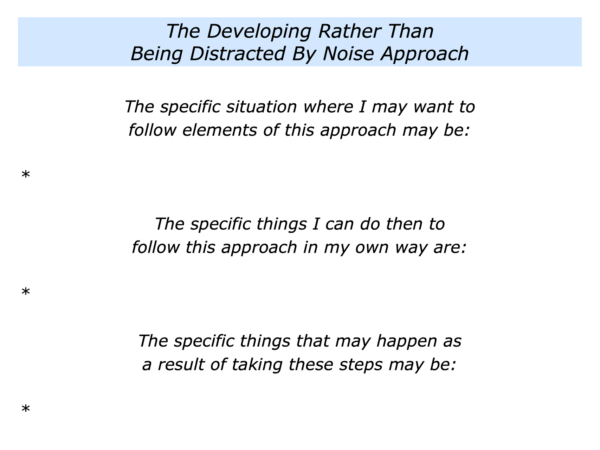


Leave a Reply